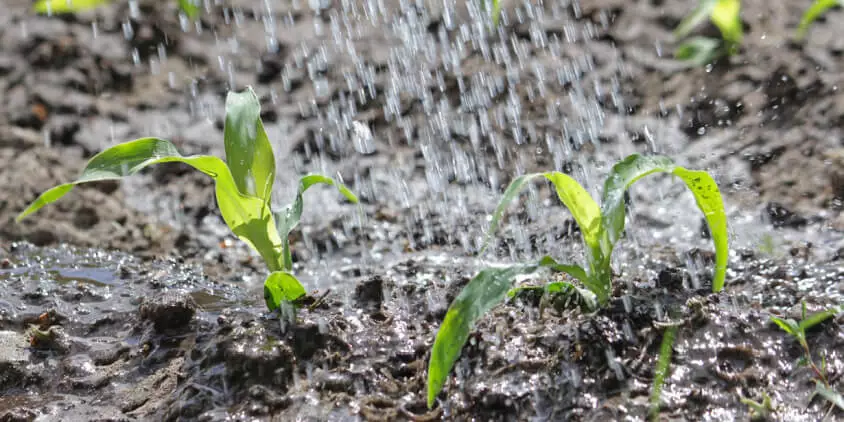
Soil Moisture: How To Measure & Monitor Its Level
Soil moisture is the critical parameter in agriculture. If there is a shortage or overabundance of water, plants may die. At the same time, this data depends on many external factors, primarily weather conditions and climate changes. That is why it is so vital to understand the most effective methods for analyzing soil moisture content. Modern farmers have a wide range of options: in addition to traditional sensors, there is modern satellite technology. Let’s take a closer look at this topic.
What Is Soil Moisture?
This term refers to the entire quantity of water in the ground’s pores or on its surface. The moisture content of soil depends on such factors as weather, type of land, and plants.
Why Is Soil Moisture Important For Agriculture
The parameter is vital in monitoring farming activities, predicting natural disasters, managing water supply, etc. This data may signal a future flood or water deficit ahead of other indicators.
Soil moisture affects:
- content of air, salinity, and amount of toxic substances;
- ground structure and thickness;
- temperature and heat capacity of the ground.
Also, this parameter prevents weathering and determines the field’s readiness for agricultural processing. Such possibilities demonstrate the importance of soil moisture measurement.
Impact Of Soil Moisture On Plant Growth
It reflects not only the water content in a particular zone but also the health of the field. The roots of plants absorb water first, so their condition directly depends on its amount and aeration. Ultimately, the soil moisture effect on plants and the yield is vital.
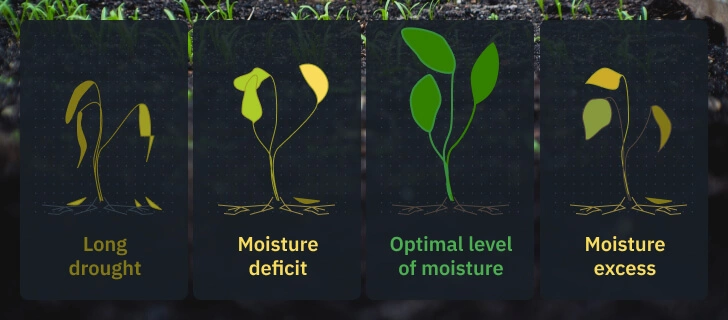
Factors Affecting Soil Moisture
This parameter depends on various indicators such as topography, vegetation, and climate. The main soil characteristics are:
- Texture: the finer it is, the more pores and, therefore, better moisture retention.
- Structure: porous structure with a high level of aggregation improves water retention.
- Organic matter content: The more organic matter there is, the more significant the water-holding capacity.
- Density: The higher it is, the less water penetrates inside.
- Temperature: moisture content is higher at lower temperatures.
- Salinity: the higher the salt content, the less water the plants can absorb, as salt is a natural absorbent.
- Depth: this factor affects the amount of water available, i.e., the deeper the soil is, the more water and nutrients the plants can get.
Optimum Moisture Content Of Soil
The desired soil moisture content depends on the field capacity (FC) and the permanent wilting point (PWP).
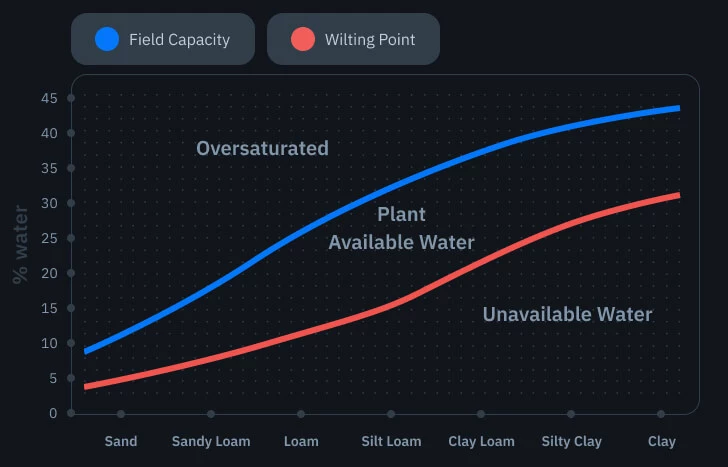
FC means how much water the soil can hold after the excess drains off. It displays the balance of water and air in the ground’s pores. There is not enough oxygen if the moisture percentage is too high. PWP reflects the temperature threshold below which plants begin to wither and die, because they don’t receive enough water. Both depend on type of soil, so it is critical to conduct an appropriate analysis to specify the optimal soil moisture range.
It is the difference between the exact water content in the ground and the water it can hold.
Also, an important indicator is total available water (TAW), i.e., how much of it plants can get. It is the contrast between the moisture content of the ground according to FC and PWP. Above FC, crops can take it only for 1-3 days; below PWP, crops cannot absorb the needed water any more. Below is a list of standard moisture content of soil for its different types.
| Ground texture | FC (%) | PWP (%) | TAW (%) |
|---|---|---|---|
| Sand | 12 | 5 | 7 |
| Loamy sand | 18 | 8 | 10 |
| Sandy loam | 23 | 10 | 13 |
| Loam | 29 | 13 | 16 |
| Silt loam | 32 | 16 | 16 |
| Sandy clay loam | 38 | 17 | 21 |
| Sandy clay | 34 | 19 | 15 |
| Clay loam | 31 | 19 | 12 |
| Silty clay loam | 30 | 16 | 14 |
| Silty clay | 42 | 21 | 21 |
| Clay | 42 | 23 | 19 |
How To Measure Soil Moisture?
There are several methods to calculate moisture content of soil. They differ in the data source that is used for this. In general, you can single out gravimetric (or direct) measurement, analysis using soil moisture sensors, and remote sensing. 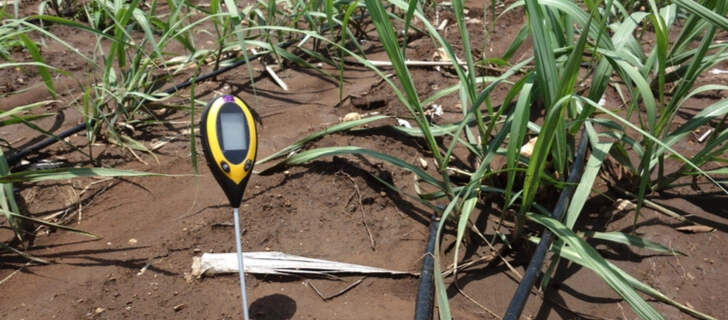
Gravimetric Soil Moisture Detection
This method extracts water from a soil sample through evaporation, flushing, and a chemical reaction. The gravimetric soil moisture is calculated based on measuring the difference between the wet and dry sample weight.
GWC (%) = [(mass of moist soil (g) − mass of dry soil (g)) / mass of dry soil (g)] × 100
Soil Moisture Analysis With Sensors
The type of a sensor depends on the used technology: measuring volumetric water content (VWC) or soil water tension (SWT), also known as soil Water Potential (SWP).
Volumetric Water Content (VWC)
This parameter (in a percentage) means the water volume to the ground volume. For example, 0.30 cubic inches of water per 1 cubic inch of ground is displayed as 30%. It can be calculated by the formula:
VWC (%) = [volume of water (in3) / volume of ground (in3)] × 100
VWC is used to calculate the water deficit in the field. It allows growers to plan precision irrigation works. In this case, soil water deficit is the ratio of general field capacity and current volumetric soil moisture content.
While VWC helps clarify water balance in the ground, calculating water potential is usually more helpful because it shows how it moves from the ground to the crop. Moreover, this parameter is suitable for specifying whether water is available to crops.
Soil Water Tension (SWT)
SWT is used to specify the energy that crops need to get water from the ground. Tension increases as moisture level decreases. Conversely, it is very low when the ground is filled with water. Usually, SWT is measured in centibar. You should constantly refine data to get accurate results. For example, try to analyze this parameter when signs of water stress appear so that you can irrigate your plants until the indicators return to normal.
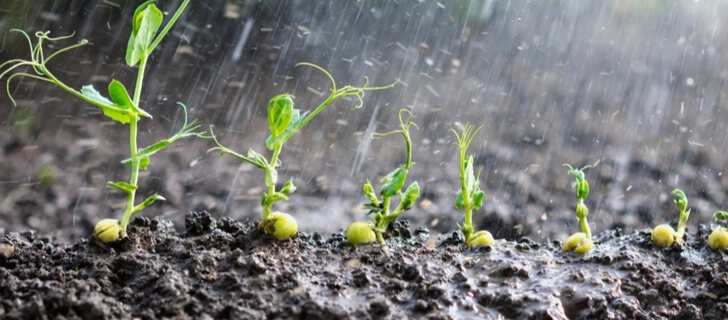
Soil Moisture Using Remote Sensing
The advantage of remote sensing is that it can gauge moisture over much larger areas than conventional methods. Additionally, satellite technology makes it possible to generate high-resolution soil moisture maps, which allow modeling crop yields in individual areas of the field and improving overall production efficiency. Given the constant development of this area, the potential of satellite data will only grow in the future.
Also, remote sensing allows growers to measure water on the surface and in the root zone. It is essential for irrigation management in drylands. As satellites’ spatial and temporal resolution increases, new opportunities for precise field control emerge. So, this technology is a solution for regions where monitoring fields with UAV or typical sensors is impossible.
EOSDA Crop Monitoring
Manage your fields with high-resolution satellite images for the most accurate and timely changes detection!
Soil Moisture Monitoring Tools
You can determine soil moisture content for plants with several tools. The choice depends on the characteristics of a particular area, but here are the most popular devices.
Tensiometers. They are tubes filled with water to measure the water stress in the ground. They take readings from the root zone of the crops. The main disadvantage of tensiometers is the need for regular maintenance.
Gypsum blocks (or electrical resistance blocks). This tool to measure soil moisture is suitable for a broader range of work than the previous one. However, it has a more fragile construction, so it must be replaced regularly.
Time Domain Reflectometry (TDR). The principle of this tool is to send an electrical signal through steel rods in the ground and then calculate the returned signal to analyze the moisture level. Dry soil produces a signal faster than wet ground. Such sensors allow accurate results to be obtained quickly. They also do not require regular maintenance. However, interpreting data with them is more complicated. Moreover, unique calibration is needed to match ground characteristics.
Remote sensing platforms. It is a complex instrument suitable for gauging various parameters. EOSDA Crop Monitoring is one of such platforms. It allows you to separate moisture content in the root and surface zones. So, you can analyze this parameter in an individual layer in detail. Moreover, EOSDA Crop Monitoring is suitable for assessing soil moisture importance for crop development, comparing the change in water level with the vegetation indices.

Using Soil Moisture Satellite Data For Field Management
Soil moisture management with satellite monitoring helps to establish practical work at any stage of plant growth.
Soil Moisture Level Defines The Appropriate Time For Sowing
Assessing soil moisture on the field levels is critical before planting. The optimal amount depends on the crop type, region, and other external factors. For example, corn and coffee suffer from excessive water levels, while rice grows well in wetlands. If you manage a single field, calculating the optimal water content is easy. However, this process is complicated and costly for large agricultural cooperatives and companies. EOSDA Crop Monitoring allows you to avoid high costs and optimize your work. So, users can add all their fields to the account and monitor soil moisture levels in each of them online. They can also use the field log to coordinate planting dates.
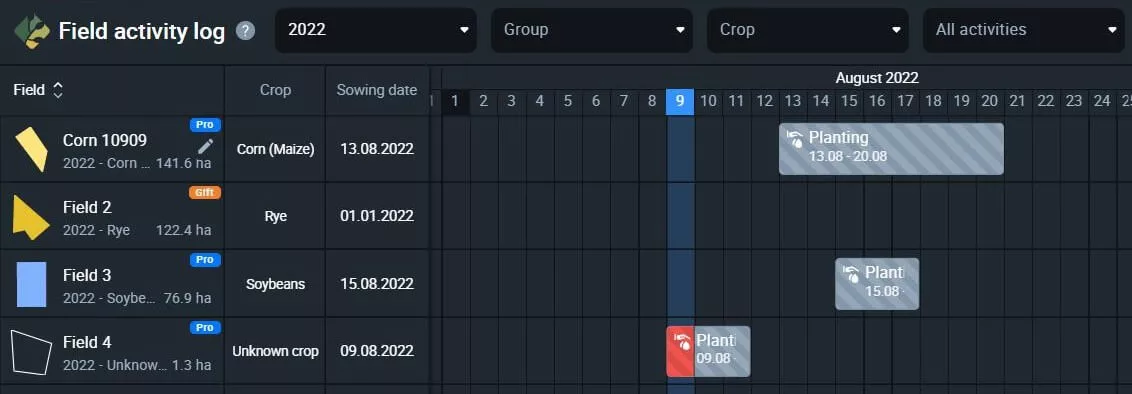
Drought Forecasting And Monitoring
Atmospheric drought is always accompanied by soil drought. The latter is displayed in a critical decrease of water due to overheating. Moreover, the concentration of soil solution rises to toxic levels. The EOSDA Crop Monitoring platform can help predict extremely high temperatures and droughts. For this purpose, users can use the 14-day meteorological forecast and historical data that help analyze drought trends in a particular region over the long term. With this information, you can effectively plan the irrigation of risk areas, maintaining optimum soil moisture for plant growth. To learn about critical temperature changes promptly, use the Weather Risk addon to receive automatic alerts.
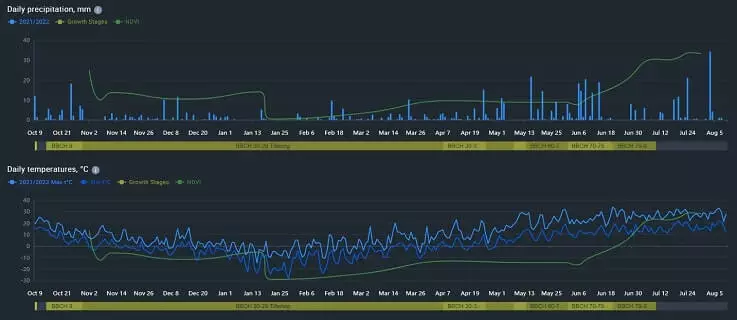
Irrigation Management
The most crucial feature of EOSDA Crop Monitoring is the determination of the water content in plants using the NDMI vegetation index. It allows you to identify areas of flooding or areas of the field where crops need to be watered.
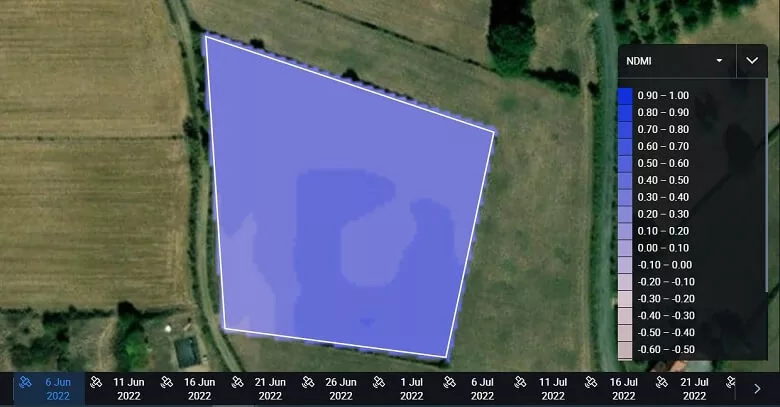
Timely detection of water stress helps to minimize crop losses. This feature can save thousands of dollars per season for large agricultural production. Identification of water stress in plants is also suitable for agricultural consultants. This feature allows them to detect the problem on time and report it to customers.
Therefore, soil moisture control and prediction are essential to ensure optimal plant growth. Precise application of remote sensing in soil moisture allows you to create the best conditions for the crop: saturate the ground with nutrients and maintain an optimal water balance. Modern smart farming technologies make it possible to automate this process and increase productivity. Moreover, the EOSDA Crop Monitoring software provides much more capabilities. It is an efficient GIS tool that you can integrate with other products using our satellite data API. For example, you can create a virtual map for an entire region. Contact our sales team to learn more about the features of our software for your needs and your product. Our R&D team will find the best custom solution for you.
About the author:
Vasyl Cherlinka is a Doctor of Biosciences specializing in pedology (soil science), with 30 years of experience in the field. He attended the engineering college in Ukraine and received his degree in agrochemistry, agronomy and soil science in the Chernivtsi National University. Since 2018, Dr. Cherlinka has been advising EOSDA on problems in soil science, agronomy, and agrochemistry.
Recent articles

Analyze 2025 & Plan Your Best Year Yet: LandViewer Christmas Offer
It’s the most wonderful time of the year! The Christmas holidays are here, and so is your chance to analyze 2025 and plan a prosperous 2026 with more affordable Pro plans in LandViewer.

EOSDA Models Climate Change Impact On Sugarcane Yields
EOSDA modeled future temperature, rainfall, and other climate impacts on Veracruz sugarcane. The results help growers plan long-term adaptation strategies, including timing, varieties, and irrigation.

EOSDA LandViewer Black Friday Sale: Exclusive Offers & Giveaway
This Black Friday, LandViewer offers new users the chance to save on monthly plans, get extra months with yearly subscriptions, and participate in a free annual plan giveaway.